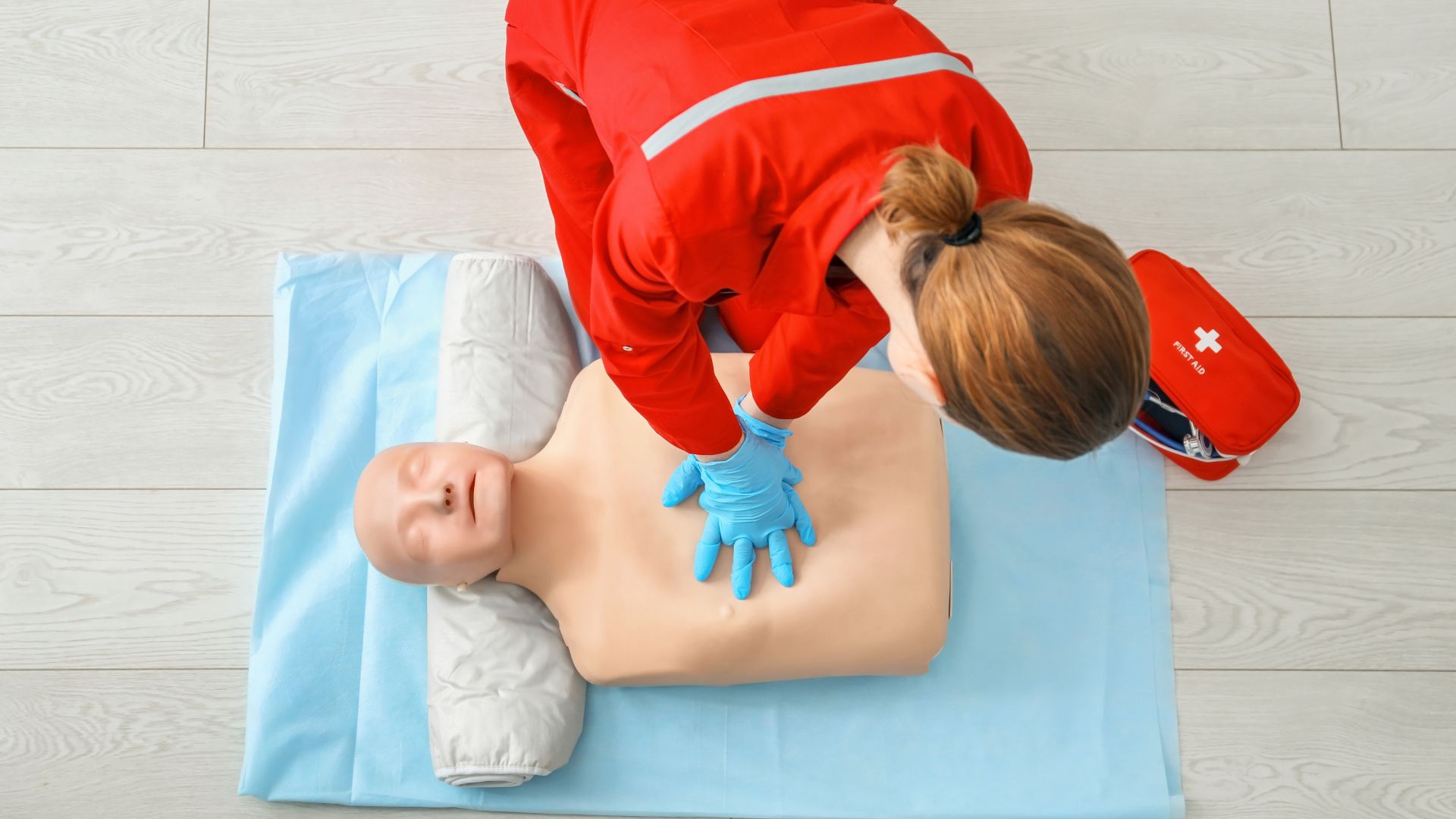Imagine you’re in a busy place when someone suddenly collapses. In that critical moment, every second counts. Cardiopulmonary Resuscitation (CPR) is a simple skill, developed through centuries of research, that can keep blood flowing until help arrives. Born initially from early, rough techniques, CPR has evolved into an easy-to-learn method that saves lives.
This guide introduces you to a skill that is both powerful and accessible—one that can make all the difference in an emergency.
Key Takeaways
- Recognizing sudden cardiac arrest symptoms, such as loss of consciousness and absence of pulse, is critical for timely intervention.
- Perform high-quality CPR by following key steps: check responsiveness, call for help, administer chest compressions, and provide rescue breaths as needed.
- Hands-Only CPR is an effective option for untrained bystanders and can be performed without rescue breaths to significantly improve survival chances.
Recognizing the Need for CPR

Identifying sudden heart attack symptoms is the first step in saving a life. These symptoms include sudden loss of consciousness, absence of a pulse, and halted breathing, indicating the heart has stopped beating effectively and requires immediate intervention.
Warning signs such as chest discomfort, shortness of breath, and palpitations may precede a heart attack, indicating the chest is struggling and requires urgent attention.
If you find someone unconscious and unresponsive, check for breathing and a pulse. If absent, they are likely in cardiac arrest and need immediate cardiopulmonary resuscitation (CPR). Quick action improves their survival chances. Do not pause compressions for too long while waiting for professional help.
Additionally, authoritative guidance from the Resuscitation Council UK underscores that timely recognition of symptoms is vital to improving outcomes.
The American Heart Association advises against delaying CPR, as even a 2-3 minute delay can reduce survival chances. Immediate high-quality CPR with chest compressions and rescue breaths is crucial once cardiac arrest is recognized.
Prompt CPR and rescue breathing can be life-saving. Every second counts and your quick response helps maintain vital blood flow to the brain and other organs until the local emergency response system – and subsequently other healthcare providers – take over.
Steps to Perform Adult CPR

CPR involves critical steps that must be followed to maximize the chances of saving a person’s life. This process is designed so the individual receives optimal care until emergency medical services arrive, including performing CPR.
Check Responsiveness and Call for Help
First, assess if the person is awake and breathing normally by tapping their shoulder and shouting. If there’s no response, act quickly.
Alert nearby people and instruct them to call 911 or the local emergency medical service, providing the dispatcher with the person’s condition and location to ensure help is on the way.
Chest Compressions
After calling emergency services, start chest compressions immediately. When performing these compressions, remember to use your body weight and rely not just on your arms; this ensures that you deliver effective, deep compressions while also making sure you press straight down on the chest.
Aim for a depth of at least 2 inches with CPR compressions at a rate of 100 to 120 per minute – always be cautious not to apply excessive chest compression depths. This helps maintain blood flow and prevents injuries.
For a child or infant, proper technique is vital—for instance, when performing compressions on a child’s chest, adjust your force accordingly while ensuring every compression is on a firm blow steadily.
Rescue Breaths
After 30 chest compressions, provide rescue breaths. Open the airway using the head-tilt, and chin-lift maneuver to clear obstructions and allow air to flow into the lungs.
Pinch the person’s nose shut, create a tight seal with your mouth over the person’s mouth, and give two breaths, each lasting about one second, ensuring the person’s chest rises and that you breathe with each breath.
Keep repeating the cycle of 30 chest compressions and two rescue breaths until emergency assistance arrives or the person begins to breathe on their own. Remember to continue CPR until then.
Hands-Only CPR

Hands-Only CPR, or Compression-Only CPR (COCPR), focuses solely on chest compressions, omitting rescue breaths. It’s particularly useful for untrained bystanders hesitant to perform mouth-to-mouth breathing and significantly raises survival chances during cardiac arrest.
Lay rescuers should perform continuous chest compressions, pushing hard and fast in the center of the chest at a rhythm of 100 to 120 compressions per minute to maintain blood flow to vital organs until professional help arrives.
Research from experts at the Mayo Clinic confirms that Hands-Only CPR can be as effective as conventional CPR in the initial minutes of cardiac arrest. If you are unable or unwilling to give rescue breaths, simply performing CPR compressions can still make a significant difference.
Using an Automated External Defibrillator (AED)
An Automated External Defibrillator (AED) is crucial in the chain of survival for cardiac arrest victims. These user-friendly devices provide voice prompts to guide you through defibrillation. Follow its instructions carefully after turning it on.
Ensure no one touches the person when the AED analyzes their heart rhythm. If a shock is advised, press the shock button after confirming everyone’s safety, then immediately resume CPR to maximize revival chances.
Proper placement of AED pads is essential for effective defibrillation. Typically, one pad is placed on the upper right chest and the other on the lower left side. If pads touch, place one on the chest and the other on the back to ensure the electrical current flows through the heart effectively.
High-Quality CPR Tips

Good CPR practices are essential for saving lives. Minimizing interruptions in chest compressions is crucial for maintaining blood flow. Each compression should allow the chest to fully recoil so the heart refills with blood.
Rescuers should rotate every 2 minutes to avoid fatigue while maintaining a steady compression rate of 100 to 120 per minute. Remember that you should start chest compressions immediately after emergency help is activated and after assessing the victim’s condition.
Additionally, for an effective airway opening, make sure you are gently tilting the head when performing the head tilt chin lift maneuver.
Common Mistakes to Avoid

Avoiding common mistakes during CPR can significantly improve resuscitation success. One critical error is failing to minimize interruptions in chest compressions, which are vital for maintaining blood flow to the brain and other organs.
Not allowing the chest to fully recoil between compressions can compromise blood circulation. Avoid excessive ventilation as it can reduce CPR effectiveness and potentially harm the person receiving it.
Post-Resuscitation Care
Post-resuscitation care is a critical phase following successful CPR. Basic Life Support (BLS) aims to preserve life until advanced cardiovascular life support is available, including monitoring vital signs and ensuring stability.
Advanced airway insertion and targeted temperature management are key components of post-resuscitation care in the out of hospital setting back. Coordinating with healthcare providers guarantees that the patient receives the best possible care. In some cases, other healthcare providers may also join in to offer specialized treatment.
CPR Training and Certification
CPR training is crucial for anyone who wants to be prepared to save a life, significantly enhancing survival chances for cardiac arrest victims. Many states now require CPR education for high school graduation, ensuring more people are equipped with these skills and essential first aid techniques.
The American Heart Association provides various resources for CPR education, including free online materials and a Find A Course Tool. Courses are available for individuals, families, workplaces, and community groups.
Completing a CPR course not only provides you with certification in adult basic life support but also integrates essential first aid principles into your overall emergency response plan.
Pediatric Note: Although this guide focuses on adult techniques, it is important to acknowledge that children require specialized care. For instance, pediatric advanced life support protocols differ from adult methods. When treating a child, ensuring a clear child’s airway, checking the child’s chest for proper compression depth, and noting the position of the child’s forehead during the head tilt chin lift maneuver are critical steps. For infants, special care should be taken when assessing the infant’s mouth and infant’s chest.
Summary
In summary, knowing how to perform CPR can make a crucial difference in a life-threatening situation. Recognizing the signs of cardiac arrest, performing high-quality chest compressions, and using an AED are all vital components of effective CPR. Hands-Only CPR is a valuable alternative for those who are untrained or unwilling to perform rescue breaths.
Post-resuscitation care and ongoing CPR instruction are equally important to ensure the best outcomes for cardiac arrest victims. By getting trained and certified, you can be ready to act confidently and potentially save a life.
Ready to get started? Visit our Contact Us page to reach out or explore our Rescue Teams for more information on certification opportunities near you. Your ability to act could be the difference between life and death—take that first step now!
Frequently Asked Questions
What are the signs that someone needs CPR?
If someone shows signs of loss of consciousness, absence of a pulse, or difficulty in breathing, they may need CPR immediately. Acting quickly can be crucial in such situations.
How fast should chest compressions be performed?
Chest compressions should be performed at a rate of 100 to 120 compressions per minute for effective results. This cadence maximizes blood flow during cardiac arrest situations.
Can I perform CPR without giving rescue breaths?
You can perform Hands-Only CPR without giving rescue breaths, as it is effective and recommended for untrained bystanders. Focus on continuous chest compressions to maintain blood circulation.
How do I use an AED?
To use an AED, turn it on and follow the voice prompts carefully, ensuring no one touches the person during analysis. Press the shock button if instructed to do so.
Where can I get CPR training and certification?
CPR training and certification are offered by various organizations. The American Heart Association, for example, provides resources and a Find A Course Tool for hands-on learning in first aid and adult basic life support, ensuring you’re prepared to manage emergencies.



